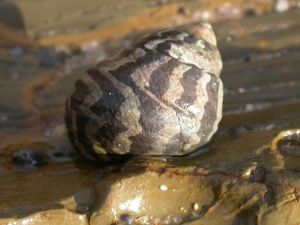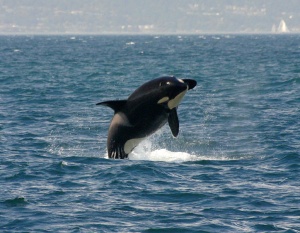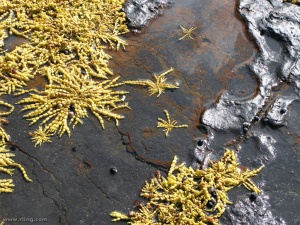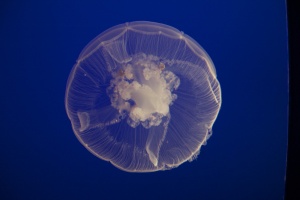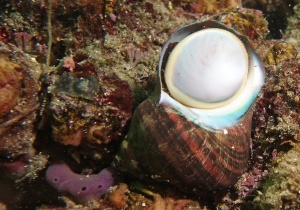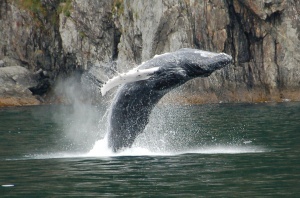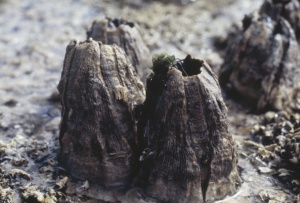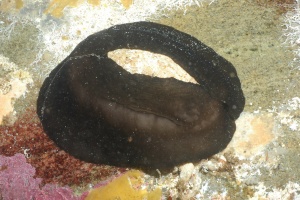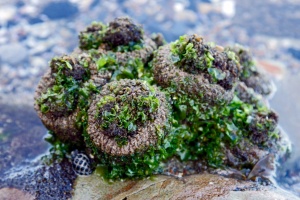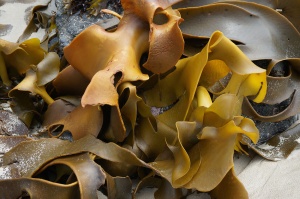Jen Sutfin
Ribbed Top Shell
A medium-sized marine snail (mollusc). They are grey or off-white in colour, with 5 - 6 distinctive ridges spiralling up towards a sharp tip (apex).
Size
25 - 50 mm
Field Guide
Improve your identification skills. Download your Ribbed Top Shell guide here!
Orca
Mostly black in colour with a light grey saddle behind the dorsal fin and a distinct white oval shaped horizontal patch behind the eye. The belly, underside of the jaw, and underside of the tail are also white. Mature males have a tall triangular-shaped dorsal fin while females and juveniles have a smaller, more curved dorsal fin.
Size
Adults reach a length of 10 m, dorsal fin up to 1.8 m in height.
Neptune’s Necklace
Its species name banksii is after the English naturalist and botanist Sir Joseph Banks.
A small, brown seaweed (algae) which resembles a beaded necklace. It has branches (thalli) which are made up of strings of hollow, water-filled, round or oval-shaped beads joined together by a short stalk. Each bead is covered in many pores, giving it a rough surface. It is attached to the substrate by a thin disc (holdfast).
Size
Fronds 10 – 30 cm long, beads 5 – 15 mm in diameter, and holdfast 3 – 10 mm across.
Moon Jelly
They have a transparent mushroom-shaped bell. Its reproductive organs form a conspicuous clover-like shape when viewed from above. Numerous fine thread-like tentacles hang from beneath the edge of the bell.
The moon jelly is a favourite food of marine turtles.
Military Turban
Large solid marine snail (mollusc) with noticeable rounded spirals (whorls). Generally smooth but some individuals show 2 strongly developed rows of spines on the body; rown or dark green striped patterns on a lighter green/fawn background.
They are fished commercially for human consumption. They are also prized bait for fisherman and can be locally fished out in some areas.
Humpback Whale
Dark grey to black on top and usually white on the belly. Humpbacks have very large, elongate pectoral fins, a small but prominent dorsal fin and a large, bushy blow (up to 5 m tall).
The large fins, dark tail with white underneath, active breaching and tendency to “hump” their backs and raise their tail out of the water before diving, distinguish humpbacks from other whales.
Size
Adult humpbacks can reach a length of up to 15 m.
Giant Rock Barnacle
Barnacles are small invertebrates that live inside hard circular or pyramid-like structures made from calcium-carbonate. They are distinguished by their size: they are taller than they are round and have similar shape to a volcano. They can be found singularly or in a group.
Giant rock barnacles are the largest type of barnacle and are comprised of six large plates that are white to light green in colour, and have top to bottom (transverse) grooves on them. They have a distinctive bright blue body (mantle) inside.
Barnacle larva are free swimming and live in the plankton layer and when they are old enough they return to the rocky shores where they find a spot and cement their heads to the rock and then grow their shell around their body.
Size
30 - 60 mm height and 25 - 30 mm diameter.
Elephant Snail
Elephant snails are a type of semi-rare solitary marine snail (mollusc) and look like a black slug with a small white, shield-like shell on their backs.
Size
70 - 150 mm
Cunjevoi
A type of sea squirt, an animal that forms large colonies as a dense mat over rocks which are highly visible at low tide.
Its shape is squat and globular. It has a thick leathery outer layer called a ‘tunic’ which is often covered with brown or green algae. Cylindrical in shape with 2 openings called siphons for inhaling and exhaling water and feeding.
Bull Kelp
A very large brown seaweed (algae). It has dark brown leathery, strap-like branches (thallus).
It attaches to the substrate by a large disc or conical-shaped holdfast. Usually there is a single leathery frond (stalk) from the holdfast, which divides into long segments or fronds.
Its strong holdfast often pulls off pieces of granite during storms which can remain attached to the kelp when washed up on shore.

